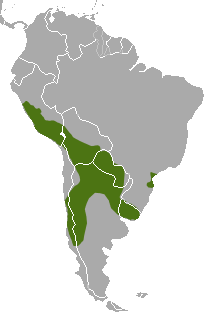|
Molina's hog-nosed skunk
Molina's hog-nosed skunk, also called the Andes skunk (Conepatus chinga), is a skunk species from South America. It is found in Argentina, Bolivia, Brazil, Chile, Peru, Paraguay, and Uruguay, at elevations up to 5000 m. HabitatThe Molina's hog-nosed skunk's native range is throughout mid to southern South America, Chile, Peru, northern Argentina, Bolivia, Paraguay, Uruguay, and southern Brazil.[2] The mammal is therefore associated with temperate regions and open areas, mainly described as the Pampas biome[3] and preferring to live in open vegetation, shrub forest and rocky sloped areas.[2] Population and distributionTypically they will live alone in an average home range size of about 1.66 individuals/km2 with some overlapping and about six skunks per 3.5 km2.[4] Although living in mostly solitary areas, the skunks will come together temporarily for mating purposes.[2] DietForaging mainly at night, the skunk is omnivorous, eating birds, small mammals, eggs, insects, leaves, and fruit. The tooth morphology in the Molina's hog-nosed skunk, is different from most mammals in that their teeth are adapted to their omnivorous diet with grinding being the main function of the carnassial apparatus.[5] Conservation statusThe skunk is listed as "least concern" according to the IUCN Red List. The main threats to the skunk are increased habitat destruction and fragmentation[6] from over exploitation of humans and grazing in agriculture. The skunk is also affected by the planning of new roads and road-kills. Due to improper planning, habitat destruction, and fragmentation, the skunk has started living around man-made structures and along fences and buildings.[6] References
Information related to Molina's hog-nosed skunk |
||||||||||||||||||||||||||||||||||
Portal di Ensiklopedia Dunia


